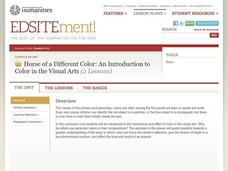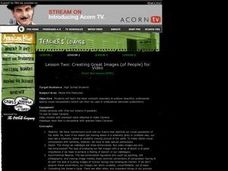LABScI
Vision Lab: The Eye
Our bodies have some amazing capabilities, but there are some limitations. Explore the limitations of the human eye through the eighth lab activity in a series of 12 biology lessons. Individuals measure their own peripheral vision and...
Exploratorium
Thread the Needle
If you are setting up a rotation lab where learners are investigating vision at different stations, this activity can be used to explore depth perception. Setting up a giant needle eye, students attempt to pass a pencil through it with...
Curated OER
Horse of a Different Color: An Introduction to Color in the Visual Arts
High schoolers identify ways in which the artist uses color to draw the view's attention to points within the composition and creates a sense of depth. They discuss the effect of color on the tone and mood of an artwork.
Curated OER
How We Perceive Movement, Depth and Illusions
Students examine how depth perception works through a class experiment. They design and perform their own experiment that investigates visual illusions.
Curated OER
In Depth with the Full Spectrum
Students explore the basic color wheel and the ways that artists use color to guide the viewer's attention through a painting's composition. A creation of a sense of depth in a two dimensional space and the effect of color on mood and...
Exploratorium
Depth Spinner
Put a new twist on your collection of optical illusion activities. Affix the linked printable spiral to a drill, record player, or some other rotating tool. Have learners stare at the spinning disk for only 15 seconds and then look away....
National Endowment for the Humanities
Lesson 1: In Depth with the Full Spectrum
High schoolers study the ways in which an artist can use color. They view various images of artwork and discuss the effect of color on spacial dimensions, focal points, tone, and mood.
Howard Hughes Medical Institute
Explore Your Inner Animals
Human bodies prove evolution thanks to our genes, bones, and more. Learning about specific body parts and how they evolved from other species helps individuals better understand the transition species that helped us become who we are today.
Curated OER
Horse of a Different Color: An Introduction to Color in the Visual Arts
Students examine how artists use color to create a sense of depth in a two-dimensional space. They view and analyze prints, complete worksheets, and write a paragraph on how color is used to draw the viewer's eye to a central figure.
Curated OER
Owl Pellets: A Fowl-Up, Chuck!
Students discover the world of owls as predators. After watching a video of owls hunting and eating, are introduced to owl pellets. Students dissect their own pellet and match the prey's bones to a bone diagram.
Curated OER
Lesson Two: Creating Great Images (of People) for Video
Students study basic concepts necessary to produce beautiful, professional looking visual compositions (which can then be used in professional television productions).
Curated OER
Tessellation Design And Construction
Young scholars study the basic elements and concepts of the visual art's perceptual component - such as shape, line and color. They create tessellations that foster problem solving and reflective thinking.













